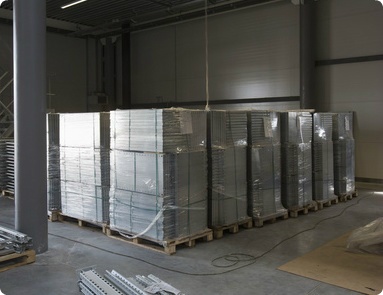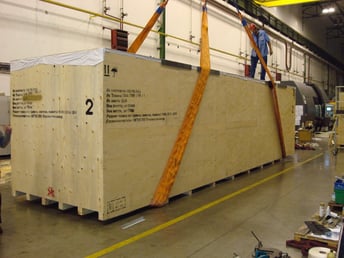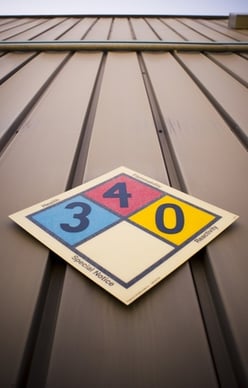
You’ve designed a product, shown it to customers, and lined up orders. You’ve designed your manufacturing process and are ready to start producing a high-quality product. You’ve hit your dates and schedules and reached all your objectives. Wouldn’t it be a shame to have done all that work and then see your product damaged while it’s shipped to its destination?
Many manufacturers and industrial companies opt for wooden crates as a default packaging solution. A wooden crate can be the right choice in some instances, but there are others in which a different material could be more appropriate.
The right one for your package depends on the specific risks it will face while traveling by land, air, or sea.
Here at Deufol, we custom design and build packages based on the unique needs and objectives of each customer. Every detail of the design is dictated by the customer’s requirements. That includes the material used to manufacture the packaging. While we often product wood crates for customers, we also offer other materials.
Below are descriptions of three of the most-commonly used packaging materials for manufacturing and industrial companies: plastic, metal, and wood. If you’re unsure of which type of package is right for you, it may be helpful to discuss it with a manufacturing consultant.
Plastic
 Plastic can be an efficient and cost-effective packaging material, and it can also be surprisingly durable. Many packagers use injection moulding to produce plastic packaging. However, injection moulding isn’t always the right strategy for many companies.
Plastic can be an efficient and cost-effective packaging material, and it can also be surprisingly durable. Many packagers use injection moulding to produce plastic packaging. However, injection moulding isn’t always the right strategy for many companies.
Injection moulding can be costly and often requires a substantial upfront investment to develop the mold. That can be problematic if you require low-quantity packaging runs or if you may need occasional changes to the package design. Each new design might require a new mold, which means more capital.
At Deufol, we often recommend thermoforming as an alternative production method for plastic packaging. Thermoforming doesn’t have the same kind of significant investment for mold development that you find with injection moulding. That means it’s less costly and time-consuming to create a new mold.
Video: Themoforming Explained [3:04] 🚀
The flexibility and cost-efficiency of thermoforming can be a valuable asset. Thermoforming allows you to quickly implement design changes to your packaging. You can produce small runs of packaging in a cost-effective manner. And thermoforming is versatile enough to meet nearly any design or quality-control requirements.

Metal
Metal is a popular packaging choice for manufacturing and industrial companies because of its durability. It’s difficult to damage and it’s effective at protecting materials from water, air, humidity, sunlight, and other elements.
Many companies also choose metal packaging because of its sustainability. Metal can often be recycled, so packaging made from metal can help you and your customers meet sustainability objectives. In some cases, you may even be able to reuse metal packaging, which can help both sustainability and cost control efforts.
The challenge with metal packaging is finding a packaging partner who is capable of engineering the material to meet your needs. Many packagers don’t have the resources to do the job effectively. If you’re interested in using metal as a packaging solution, look for a packaging partner who has the engineering and fabricating resources needed to craft a package that meets your needs.
Wood
 While plastic and metal have their advantages, there are still many situations in which wood is the best option. Wood can be cost effective and it can be easily crafted to meet a wide range of size and shape requirements. Wood crates are also easy to assemble, which means you may be able to produce them in-house.
While plastic and metal have their advantages, there are still many situations in which wood is the best option. Wood can be cost effective and it can be easily crafted to meet a wide range of size and shape requirements. Wood crates are also easy to assemble, which means you may be able to produce them in-house.
Of course, there are challenges that come with wood crates. One is that they can be costly if not designed properly. If you’re not using reusable packaging, you may have to purchase new materials every time you need a package. Wood crate production is also difficult to automate, so labor costs could be an issue.
Quality could be a concern with wood crates. They may be vulnerable to water, extreme temperatures, sunlight, and more. If you opt for a wood package, you may need interior barriers or dunnage to ensure product quality while in-transit.

Preservation Materials
Regardless of which material you use for your package, you may ultimately need preservation protection to keep the package safe while in transit. There are a broad range of preservation materials available. The right one for your package depends on the specific risks it will face while traveling by land, air, or sea.
Corrosion is one of the biggest threats that products and packages face while in transit. It’s not the only risk, though. Depending on your product, materials, and method of transport, your package could be vulnerable to water damage, light exposure, extreme temperatures, and even volatile movement within the container.
The best way to determine the most effective form of protective packaging is to conduct a risk analysis of your product and package. That analysis will highlight the threats that are most likely to occur and the threats that could cause the most damage.
Protective material options could include heat shrink or foil with volatile corrosion inhibitors (VCI). Foams and cushions with VCI emitters can protect against corrosion and movement. Other solutions include containers vacuum-packed with desiccants and even materials applied directly to the product, like cosmoline oils and spray powders. Again, an experienced and knowledgeable packager can conduct a risk audit and help you choose the most effective protective materials.
There’s no universal answer as to which material is best for packaging. It depends on your unique needs, goals, and budget. You’ll be best served by working with an experienced and knowledgeable packaging consultant who has expertise with a broad range of material options. They can analyze your needs and recommend the material that’s right for you. ![]()





Let Us Know What You Thought about this Post.
Put your Comment Below.